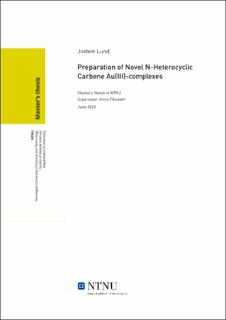| dc.contributor.advisor | Fiksdahl, Anne | |
| dc.contributor.author | Lund, Jostein | |
| dc.date.accessioned | 2021-09-28T18:27:19Z | |
| dc.date.available | 2021-09-28T18:27:19Z | |
| dc.date.issued | 2020 | |
| dc.identifier | no.ntnu:inspera:52692076:22733907 | |
| dc.identifier.uri | https://hdl.handle.net/11250/2785414 | |
| dc.description.abstract | Sammendrag
I dette prosjektet har to unike imidazolium N-benzyl, N-metylene - (C4-substituerte) -oxazoline imidazolium NHC-forløpere 7a (iPr-C4) og 7b (tBuC4) utarbeidet i tre trinn.
En kondensasjon av de chirale amino alkoholene 1a, b med 2-kloroacetylklorid (2) ga de tilsvarende chirale amidene 3a, b. Amidene 3a, b ble deretter utsatt for en intramolekylær \ dehydrering i nærvær av Burgess ’reagens, og produserte klormetyloxsazolinene 5a, b. Oxazolinene 5a, b gjennomgikk en halogenutveksling til sine joderte motparter, ved Finkelstein-protokollen, før den endelige N-alkyleringen med 1-benzylimidazol 6 ga imidazoliumsaltene 7a, b (50 %, 77 %), med et samlet utbytte på henholdsvis 21 og 22 % for imidazolium salt 7a og 7b. Imidazolium-saltene (7a, b) ble koordinert til et gullsenter (I) ved transmetallering fra et sølvintermediat, som ga de nye Au (I) NHC-kompleksene 8a (69 %) og 8b (18 %).
Variasjonen i oppnådde utbytter av Au(I)NHC-kompleksene 8a, b antyder at fremstillingen av Au I)-komplekset 8b er heftet av en mer sterisk hindret ligand (tBu) enn Au (I)-komplekset 8a (iPr).
De nye Au (I) NHC-kompleksene (8a, b ble oksidert til deres tilsvarende Au (III)NHC[Cl3] - komplekser 10a, b med diklor-jodbenzen og et påfølgende anion-bytte for å gi bidentate C, N- Au(III)NHC[oxazoline]-kompleksene 11a, b.
Mens ingen av de fire Au(III)-kompleksene ble isolert eller fullstendig karakterisert, ble deres urensede reaksjonsblandinger analysert med 1H-NMR og 1H,15N-HMBC . Endringene i 15N- skift (DeltaNox, DeltaNAE ) for nitrogenatomene ved oksidasjon og anionebyttekoordinasjon indikerer sterkt dannelsen av Au (III) NHC [Cl3]-kompleksene 10a, b og bidentatet C, N-Au(III)NHC[Oxazoline] complex 11a. | |
| dc.description.abstract | Summary
In this project, two unique imidazolium N-benzyl, N-methylene-(C4-substitued)-oxazoline imidazolium NHC precursors 7a (iPr-C4) and 7b (tBu-C4) NHC precursors have been prepared in three steps.
A condensation of the chiral amino alcohols 1a,b with 2-chloroacetyl chloride (2) yielded the corresponding chiral amides 3a,b. The amides 3a,b were then subjected to an intramolecular dehydration facilitated by Burgess’ reagent, and produced the chloromethyl oxazolines 5a,b. The oxazolines 5a,b underwent a halogen exchange to their iodized counterparts, utilizing the Finkelstein protocol, before final N-alkylation with 1-benzyl imidazole 6 to afford the imidazolium salts 7a,b (50%, 77%), with an overall yield of 21 and 22% for imidazolium salt 7a and 7b respectively.
The imidazolium salts (7a,b) were coordinated to a gold(I) atom centre by transmetallation from a silver intermediate, which yielded the novel Au(I)NHC-complexes 8a (69%)
The large difference in obtained yields of the Au(I)NHC-complexes 8a,b suggests that the preparation of the Au(I)-complex 8b is obstructed by a more sterically hindered ligand (tBu) than the Au(I)-complex 8a (iPr).
The novel Au(I)NHC-complexes (8a,b were oxidised to their corresponding Au(III)NHC[Cl3]- complexes 10a,b by dichloro-iodobenzene and subsequent anion exchange to give the bidentate C,N-Au(III)NHC[oxazoline] complexes 11a,b.
While neither of the four Au(III)-complexes were isolated nor fully characterised, their crude reaction mixtures were analysed by 1H-NMR and 1H,15N-HMBC . The changes in 15N-shifts (DeltaNox, DeltaNAE) for the nitrogens atoms by oxidation and anion exchange coordination strongly indicate the formation of the Au(III)NHC[Cl3]complexes 10a,b and the bidentate C,N-Au(III)NHC[Oxazoline] complex 11a. | |
| dc.language | eng | |
| dc.publisher | NTNU | |
| dc.title | Preparation of Novel N-Heterocyclic Carbene Au(III)-complexes | |
| dc.type | Master thesis | |
